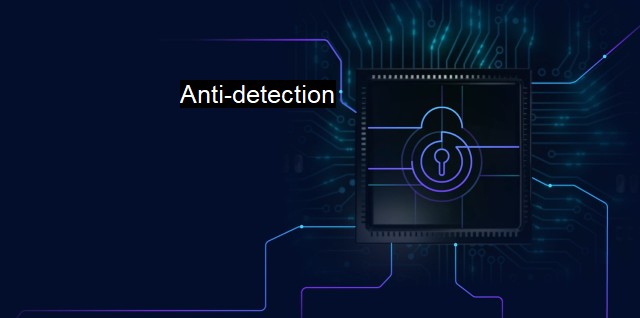What is Anti-detection?
The Importance of Anti-Detection Techniques in Cybersecurity: An Overview of Obfuscation and Other Strategies to Evade Detection by Threats and Tools
"Anti-detection" holds a prominent status. It is an umbrella term that refers to a set of sophisticated technical methods and techniques applied by cybercriminals to help avoid detection by advanced security measures, mainly antivirus software.Anti-detection techniques offer cybercriminals a treacherous path to bypass security layers and operate unhindered, resulting in far-reaching ramifications, notably, the significant loss of sensitive data and the incapacitation of system functionality. A growing trend among modern strains of malware is the consistent application of anti-detection techniques, aiming at lasting longer on the system, therefore maximizing the exploitation.
Primarily, anti-detection techniques can be categorized into two prominent categories: Obfuscation and Polymorphism.
Obfuscation techniques seek to hide the true intentions of a piece of malicious code by modifying its conventional visible aspects. A key tool in obfuscation is packers, which work by encrypting the payload of a malicious program. The packers themselves are not harmful; they can house benign or malicious programs. Nonetheless, when they contain malware, antivirus software must first decrypt the payload to identify it as harmful.
Crypters are another technique often used in obfuscation. They encrypt malware using a unique key that is only provided once the malware has been successfully delivered to its target. Again, this makes it significantly more challenging for antivirus software to discern the true nature of the program.
Polymorphism, on the other hand, is a bit more versatile and encompasses a few different anti-detection methods. Mainly, the purpose of polymorphism is to change the code of a piece of malware every time it moves to a new system. Such iterations present an unthinkable challenge to traditional signature-based antivirus software.
A popular polymorphic strategy is metamorphism, which doesn't merely change a few trivial traits of the code to elude antivirus software. It incorporates randomization into anti-detection and procession functionality to achieve almost an entirely new program with each iteration.
Similarly, oligomorphic and polymorphic codes pose equal complexity. While the former refers to multiple encryptions using varying keys, the latter indicates producing millions of iterations by paralyzing the malware analysis.
Reflectively, sleeper cells—a concept borrowed from espionage literature—tactics are increasingly appreciated. The malware remains dormant on a system, making no malicious attempts, hence passing initial security screenings. Once good to go, it retrieves its harmful functionality.
Antivirus programs have been attempting to overcome these anti-detection techniques with mixed success. Primarily, heuristic methods are employed that focus on recognizing harmful behaviour patterns instead of relying solely on file signatures. Emulators perform preliminary scanning to ensure unrecognized executables do not go viral.
As the anti-detection schemes get stealthier, the antivirus measures are persistently putting up daring fights to combat such threats. The spiral doesn’t seem to halt any soon enforcing an unending cycle that is only set to enhance their sophistication.
To have any chance of overcoming these ever-evolving anti-detection strategies, a rigorous cooperative mitigation strategy is indubitably needed. A context-aware security posture combining multiple screening layers, automated and manual code analysing, behavior profiling, traffic analysis, and most importantly, educating the users about phishing attacks and general cybersecurity norms can potentially revamp the situation.
As the landscape of cyber-threats continually grows and evolves, so too does the discipline of cybersecurity and antivirus. Anti-detection serves as a grim reminder of the lengths cybercriminals go to breaching confidentiality for ill-intended goals. Yet, simultaneously, it provides motivation and impetus for the cybersecurity world to continue developing tools and methodologies to keep the modern digital environment safe and secure. It's indeed an area that will continue to spawn headaches for IT experts but simultaneously opportunities for technical innovators to sculpt out potent counteracting solutions.

Anti-detection FAQs
What is anti-detection in cybersecurity?
Anti-detection in cybersecurity refers to techniques used to avoid detection by antivirus software or other security measures.Why is anti-detection important in cybersecurity?
Anti-detection is important in cybersecurity because it allows cybercriminals to carry out their malicious activities without being detected or caught by security measures.What are some common anti-detection techniques used by cybercriminals?
Some common anti-detection techniques used by cybercriminals include the use of obfuscation, encryption, polymorphism, and rootkits.How can organizations protect themselves against anti-detection techniques?
Organizations can protect themselves against anti-detection techniques by using a layered approach to security that includes antivirus software, firewalls, intrusion detection, and other advanced security measures. They can also conduct regular testing and update their security systems to stay ahead of emerging threats.| | A | | | B | | | C | | | D | | | E | | | F | | | G | | | H | | | I | | | J | | | K | | | L | | | M | |
| | N | | | O | | | P | | | Q | | | R | | | S | | | T | | | U | | | V | | | W | | | X | | | Y | | | Z | |
| | 1 | | | 2 | | | 3 | | | 4 | | | 7 | | | 8 | | |||||||